Cold Lunula Laser Fungal Nail Treatment – Specialists on the Sunshine Coast
By far the most effective fungal nail treatment is laser treatment. Within this category the gold star nail fungus laser treatment is Lunula Laser. Lunula Laser uses cold wavelengths to provide highly effective fungal nail laser treatment. It is in high demand due to the pain free nature of the treatment and high efficacy levels.
Suncoast Podiatry was among the first podiatrists on the Sunshine Coast to introduce cold fungal nail laser treatment to it’s foot and nail clinics across the Sunshine Coast with clinics located at Noosa, Cooroy, Bli Bli and Gympie and are experts in fungal nail eradication.
Read on to learn about how fungal nail infections form, the various therapies available for fungal nail infections and for an in depth look at fungal nail laser treatment.
What is Fungal Infection of the toenail? (Onychomycosis)
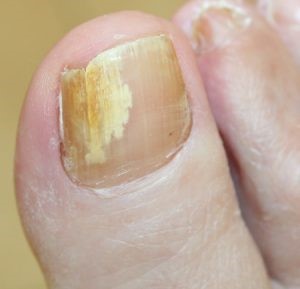
prior to treatment at one of our foot and nail clinics on the Sunshine Coast
Fungal infections of the nail (also known as onychomycosis) are identified by an unsightly thickening or discolouration of the nail. It may be yellow, orange, brown or white. Nails may crumble, become brittle or thickened. The nail may lift from the end of the toe & malodorous fungal debris can collect under the nail.
It may cause embarrassment, self-consciousness and pain when wearing shoes. Ingrown toenails and corns may form around the nail. The fungus can cause recurrent Tinea Pedis which may be dangerous to those with other health problems such as Peripheral Arterial Disease, leg ulcers or Diabetes.
If you are experiencing persistent symptoms of fungal nail infection please make an appointment with one of our Sunshine Coast Podiatrists before your infection progresses.
What causes fungal nail infection?
Fungal nail infections often result from damage to the nail plate or seal, which allows a fungus or athlete’s foot to invade the nail. 30% of patients with fungal nails also have Tinea. Hot, sweaty feet in shoes provide the ideal warm, damp environment for fungi to thrive.
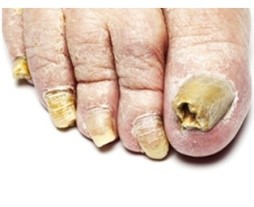
Fungal nail infections are caused primarily by dermatophytes, but also candida and the various yeasts and moulds that thrive in these conditions. The dermatophyte Tricophytum Rubrum, is responsible for about 90 per cent of all nail infections. Factors that increase the risk of nail infections are:
- nail damage or biting
- medical conditions e.g. Diabetes, Psoriasis, or weakened immune system
- smoking
- general poor health
- activities involving impact or shared washing facilities
- trauma to the nail – for example, running, poorly fitted footwear or some Pedicures where instruments are not sterilised correctly
How can I treat Nail Fungus?
There are many treatments available to eliminate/control fungal nail infections. To determine the best treatment choice for you, we recommend visiting one of our foot and nail clinics on the Sunshine Coast. We service areas such as Noosa, Cooroy, Gympie, Bli Bli and Pomona. Our podiatrists may recommend any of the following treatments.
- Topical (paint on) treatments. Need to be used daily, do not penetrate the nail well.
- Oral medication. Can have side effects including Liver impairment.
- Surgical removal of nail. Can be effective for some people. Risk of infection, difficulty wearing enclosed shoes after removal.
- Thermal laser is effective but can be uncomfortably hot. Not all patients can tolerate.
- Lunula ‘Cold’ laser. Painless, quick, drug free. The best fungal nail treatment. We have experienced success rates of around 95%.
Paint on medicines can be ineffective and take many months to clear the infection. A typical 9 month course of anti-fungals may cost over $600 and regular Podiatrist visits are generally also required to reduce the thickness of the nail.
If you are embarrassed by this unsightly condition, there is a now a new cutting edge and clinically proven treatment known as Lunula Laser that is quick, effective, painless and without side effects.
Lunula nail laser therapy works by destroying only the fungal cells in the nail, leaving healthy cells intact. 83% of patients report clear, healthy nail growth at 3 months. Between 5 – 6 treatments are typically required. A specialised laser is directed onto the nails and nail beds, the procedure is painless and takes no more than 30 minutes.
We find the greatest success rate occurs with the Lunula Laser fungal nail treatment.
Suncoast Podiatry is currently the only Podiatrist on the Sunshine coast to offer this service.
Contact us today for further details and our current rates.
Alternatively, if you have questions fill out the form below and we will get back to you.
 Why is Lunula Laser so effective?
Why is Lunula Laser so effective?
Lunula Laser is the only laser to use dual-diode Class 2 laser. It combines the anti-fungal effects of the 405 nm wavelength with the regenerative outcomes of a 635 nm wavelength.
The Lunula fungal nail laser treatment produces two wavelengths, 635 nm and 405 nm, both of which are enriched by a rotating line-generated laser beam. The Lunula’s specially designed delivery mechanism maximizes both photon concentration and treatment surface area. The Lunula’s patented delivery system ensures that all infected tissue, nail bed and most importantly, the proximal germinal/matrix tissue are properly targeted and treated, making it the most effective fungal nail laser treatment available.
What’s in a Wavelength?
Higher wavelengths produce more heat. Wavelengths of 900nm or higher produce an increase in temperature in the tissue being treated. Lower wavelength lasers do not rely on heat production. Cold lasers initiate true physiologic responses. The lower the wavelength the greater the anti-microbial/antifungal effect. This wavelength also induces tissue rejuvenation and increased bloodflow, accelerating clear nail growth.
 Why don’t all Podiatrists offer Lunula Laser?
Why don’t all Podiatrists offer Lunula Laser?
Quite simply, COST! Lunula Laser’s technology make its cost prohibitively expensive for most Podiatrists. At Suncoast Podiatry, our locally owned practice is committed to consistently investing in Gold-Standard, industry leading technology for our patients.
What are the benefits of Lunula Low Level Laser?
There are numerous benefits from this type of fungal nail laser treatment including:
- No pain
- No chance of developing microbial resistance
- No interactions with any medication
- No chance for liver toxicity
- Treats the entire nail bed, plate and surrounding skin
How many treatments will I need?
Between 2 & 4 treatments are typically required. Severe infections may require further treatments.
 What can I do to prevent re-infection?
What can I do to prevent re-infection?
Fungal spores live in shoes & can easily re-infect your nail. Steri-shoes sanitizes the inside of shoes by using germicidal ultraviolet (UVC) light. 1 pair of shoes are treated free of charge with your consultation. Additional pairs can be treated for $10.
You may also like to consider purchasing some specialised shoes from our range. If you need help selecting, please contact our helpful staff.
How long does it take to get rid of toenail fungus with laser treatment?
Results are not immediate, but rather as the nail grows you will notice new, healthy growth from the nail base (epynichium). Nails grow slowly so a complete result is observed months following the procedure.
Will I need more than one fungal nail laser treatment?
All of the published studies show a positive result in over 80% of cases. However, further treatments may be indicated for severely affected nails and persistent fungal strains. Your Podiatrist will discuss the possibility of having additional treatments and will also advise you on the proper care of your nails to minimize the risk of recurrence.
Clinical Data Summary:
Treating Onychomycosis with 1064 Laser, Charles Muster, DPM, July 2011
Does thermal laser treatment for fungal toenails work?
Heat Laser fungal nail therapy does work reasonably well. The main problem our podiatrists find in our foot and nail clini cs is that many people do not tolerate the heat from the laser.
Please talk to our podiatrists about the best treatment for you.
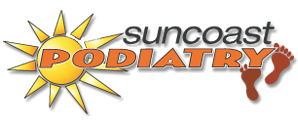
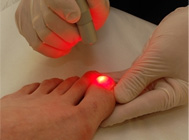
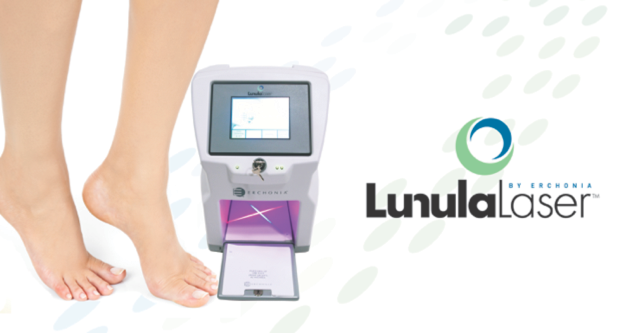 Why is Lunula Laser so effective?
Why is Lunula Laser so effective?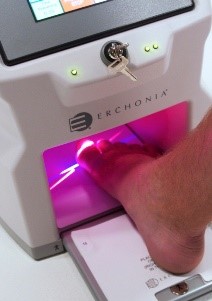 Why don’t all Podiatrists offer Lunula Laser?
Why don’t all Podiatrists offer Lunula Laser?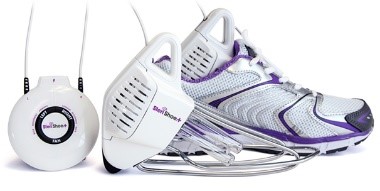 What can I do to prevent re-infection?
What can I do to prevent re-infection?